| Columns Retired Columns & Blogs |
and the table has that wild cut-out in the back! Love that design. Great numbers and I would imagine that this is a contender at its price.
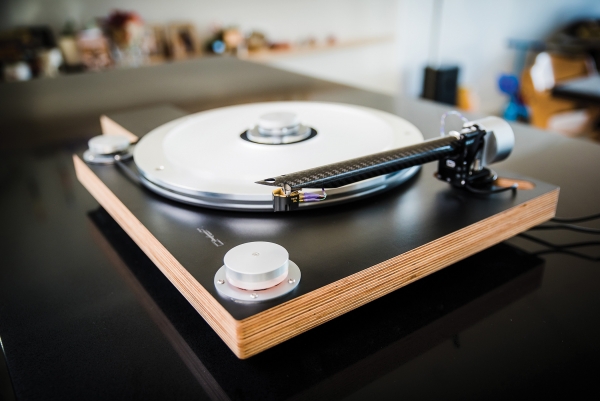
In prior screeds, I have discussed the category of turntable designers I like to call deep thinkers, who twist their brains to come up with fresh thinking about how to approach the task of playing a vinyl record. If there is a poster boy for deep thinkers, it's got to be Simon Brown.
Brown is based on the South Island of New Zealand. I'm thinking that being in such a far-flung part of the world must have given his head plenty of space to get creative. First, in 2011 he created The Wand tonearm, a striking unipivot design that features a fat carbon-fiber armtube nearly 1" in diameter (below). Art Dudley wrote about The Wand in 2019, and I highly recommend that you read his thoughts, especially about his struggles to set up The Wand. Over the years, I have worked on a few Wands out in the field, so I'm pretty well acquainted with their fiddliness. If you're the type of person who gets sweaty palms at the thought of installing and aligning an expensive and fragile cartridge on your turntable, I recommend you seek experienced assistance.
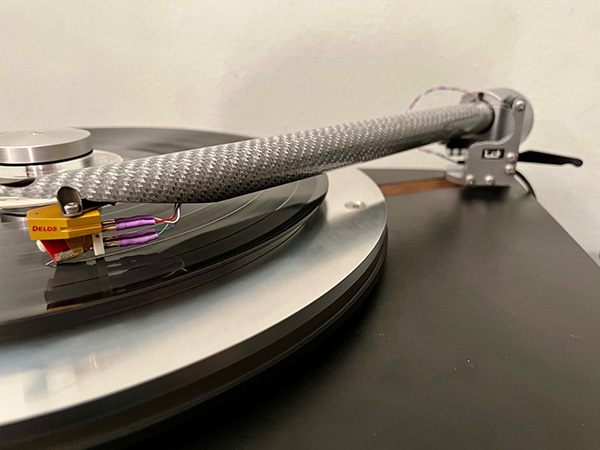
While the Wand arm has been around for quite a while, The Wand 14-4 turntable is more recent(footnote 1). The name comes from the turntable's platter: the larger size (14") increases rotational inertia without adding significant mass; the platter has four layers including an aluminum/acrylic/aluminum sandwich (for damping) plus an acrylic mat to interface with the record.
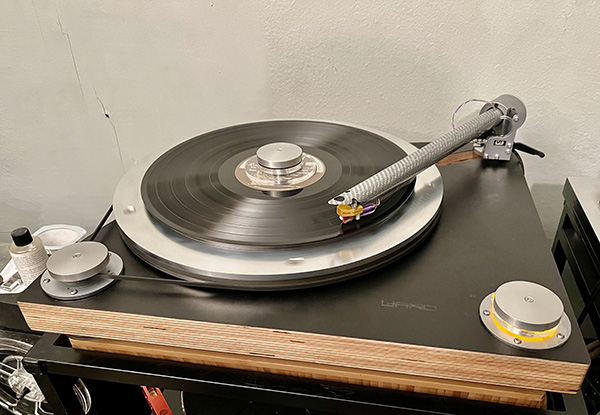
Despite the unusual platter, the most visually striking feature of the 14-4 is the plinth, made from a 1 3/8"-thick slab of German plywood cut into what at first appears to be a quarter section of a large circle. Closer inspection reveals that it has a slightly squashed radius on the curved face, which extends from the front left corner to the right rear, and that the straight sides are unequal in length. Several holes of varying size are punched through the plinth underneath the platter, positioned to break up panel resonances and block vibrations from reaching the arm mount. The structure is supported on three adjustable feet with built-in elastic suspension bands, providing isolation and allowing leveling.
A DC motor is mounted in the front left corner, capped with a large, flat knob that visually matches the power and speed control knob in the front right corner. A thick, flat, Swiss-made belt goes around the platter's perimeter, then under the wide, knoblike part of the motor pulley. Don't do like I did and try to get the belt to ride on the pulley's thick knob; it's wrong and will just fall off. Normally, I would say it's time to "read the freakin' manual, Michael," but the manual is sketchy at best, glossing over a lot of fiddly details. The website isn't much help, either, with various PDFs, videos hosted under different user names and platforms, and information scattered around the site and hard to locate. Brown says this is all being addressed.
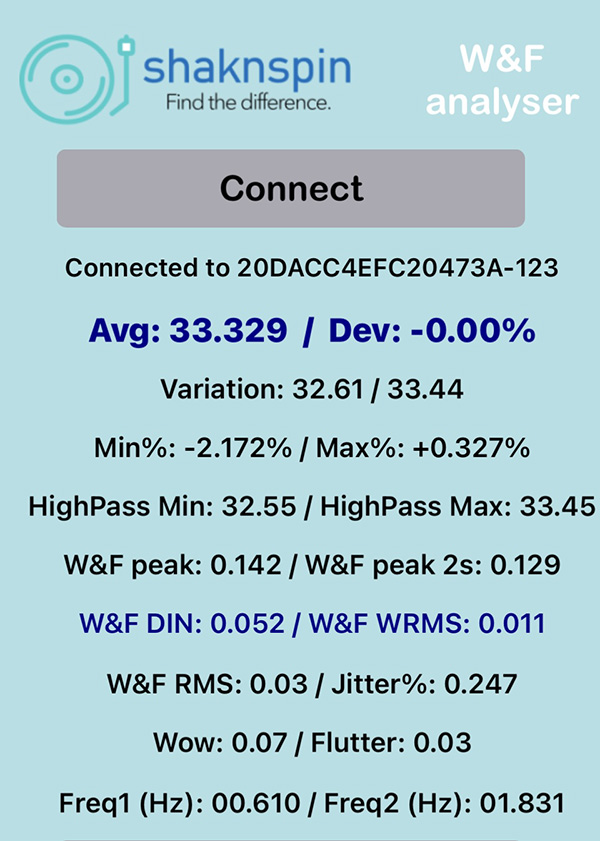
An inline switching power supply connects to a recessed socket near the motor; a battery supply is available as an option. Once you have it up and running, a speed sensor under the platter automatically adjusts the speed; I found the speed was spot on at both 33 1/3 and 45 (above). Finally, while my review sample came without it, a new 14-4 will come with a lift-off dustcover that sits on the platter and has a flap that extends over the tonearm.
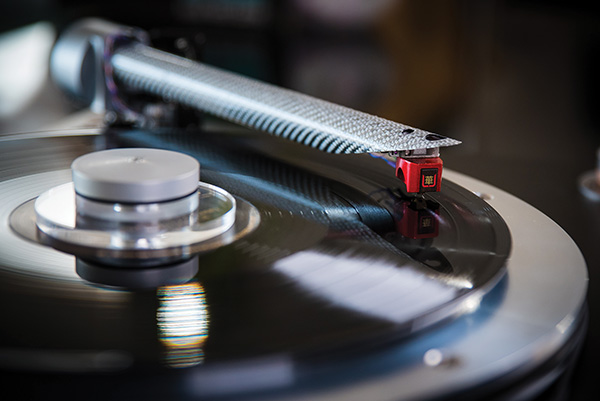
As easy as the turntable is to set up, the tonearm is a heart-pumping challenge. Art outlined some of the difficulties in his piece, but he didn't mention how the multipurpose alignment tool, with its built-in sharp-edged metal-arc protractor, threatens to slice off your cantilever and stylus if you jiggle it the wrong way. I'm normally as comfortable as anyone handling big-dollar cartridges, but trying to use this tool was giving me hives, so I gave up and used my Feickert protractor.
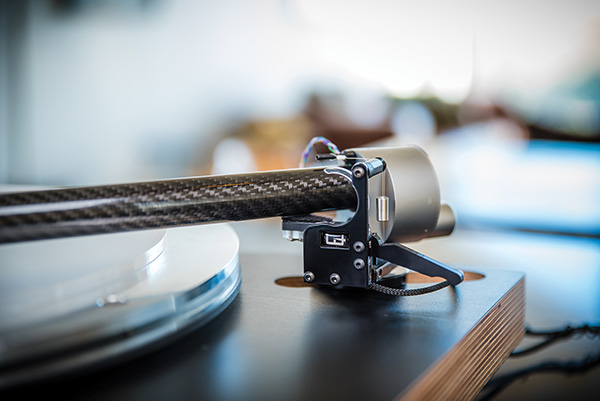
I have found that, with unipivots like this one and VPI's, you can position the protractor by removing the arm wand, then lining up the protractor's pointer with the unipivot cup. Tape down the platter and protractor so that they remain in position and remove the protractor's beam and pointer so that it's out of the way. Doing it this way felt way safer, less of a risk to my Lyra Delos cartridge.
A long slot is provided for mounting the arm, allowing use of three of the four available Wand lengths—9.5", 10.3", or 12"—without modification. The arms also come in three performance levels, Plus, Master Lite, and Master; only the Master is available in the 14" length. The two upper levels have addition damping in the armtube and improved wiring; the Master arm adds a vernier-scale VTA adjustment. I received the 12" Master Lite arm, also called the Wand S some places on the website.
A potential concern when using the 12" arm on the 14-4 turntable is that the arm's length means that the cartridge ends up hovering precariously close to the power and speed selector knob. I'm sure you would get used to it, but it's easy to imagine bumping into the stylus when reaching for the knob, especially after imbibing a bit too much. Another lurking danger is the oversized platter: If you miss the mark while lowering the stylus onto the lead-in to the record, you could land the stylus on the outer lip of the platter, where there are several screws holding the platter's layers together.
They say that with great sacrifice comes great reward. The Wand turntable and tonearm is a perfect example of that. I have more experience than most with difficult-to-wrangle turntables and tonearms, but this one nearly had me crying for my mama. When it was done, all the pain and struggle was forgotten as I fell into the music.
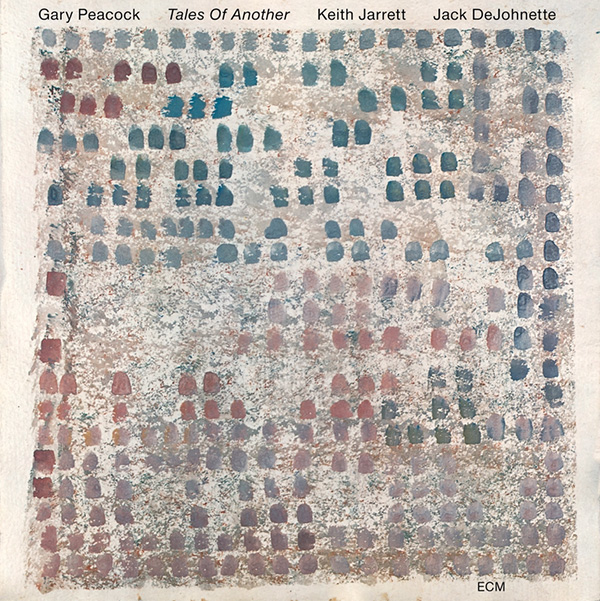
Performance: First up, I played "Vignette," from jazz bassist Gary Peacock's 1977 album Tales of Another (ECM 1-1101). Featuring pianist Keith Jarrett and drummer Jack DeJohnette, this trio reconnected a few years later to become Jarrett's jazz-standards trio, with the pianist taking over as leader. Even at this earlier date, it's pretty clear that Jarrett was already in the driver's seat. This is a fairly dry-sounding record, but that only helped to make even clearer the Wand's extraordinary ability to present vivid shades of a rich tonal palette, each instrument sounding remarkably realistic and true. I have never before heard Gary Peacock's recorded sound presented with such clarity and vividness. With DeJohnette's snare, you could clearly hear the internal acoustic of the drum as he tapped lightly on the tightly tuned top head, each buzz from the snares sounding focused and resolved.
Switching gears, I put on Let It Be by Slovenian industrial band Laibach (Mute STUMM 58). This 1988 record is an almost unrecognizable cover of The Beatles album of the same name, although it omits the title track. Most of the songs have a symphonic-industrial sound with marching beats, grunted vocals, and choirs, but their version of "Across the Universe" with guest vocalist Anja Rupel is beautiful. This song, though, can be challenging to make sound good. With the wrong gear or setup, Anja's multitracked vocals can sound a bit thick and congested. The Wand managed to unravel this thicket of sound, clarifying and opening things up.
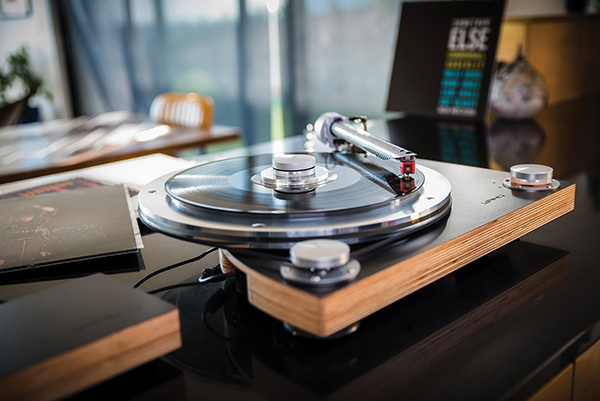
The Wand turntable and tonearm are clearly the creation of a single person, Simon Brown. There are no compromises here, and few concessions to ease of setup and use. But if you're willing to put in the work and deal with the setup anxiety, your patience will be rewarded with extraordinary performance. The Wand excels in areas I consider fundamental to musical enjoyment, such as tonal color and timing. The Wand will extract the most from your cartridge. There's nothing warm or sluggish sounding about The Wand, but because it's able to resolve detail so well, it never sounds thin or anemic. "Vivid" and "focused" are the words that keep popping into my head. Definitely recommended—as long as you understand what you're getting into.

and the table has that wild cut-out in the back! Love that design. Great numbers and I would imagine that this is a contender at its price.

I run a DIY PTP Lenco L75, 10" Wand Plus tonearm, and a rebodied and retipped Denon DL103.
Between you and Herb, you've basically covered my whole front end in the last month. Kinda fun to read positive reviews on the gear that I use and really enjoy every day! I've not experienced that before. Cheers and Happy New Year!

I had my table and arm unpacked and set up in about an hour. Not really that complicated. Instructions were clear enough, videos were helpful as well. I would not let setup deter you from owning this wonderful table and arm.

Though I'd love to, I'll never own, and, almost certainly, never even see or hear a Wand turntable or tonearm. I can, though, listen, as I am right now, to the music that you used in your session with them. "Vignette" is totally magical, from the first dance of the cymbals, and I might not have ever heard it, had I not read this review. I am in your debt, sir!